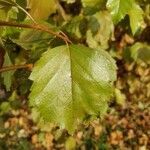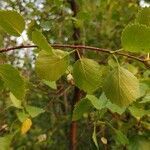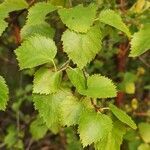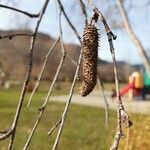Shrubs , spreading, to 10 m. Bark dark reddish brown to bronze, smooth, close, not readily exfoliating; lenticels pale, horizontally expanded. Twigs without the odor or taste of wintergreen, glabrous to sparsely pubescent, covered with conspicuous, reddish, resinous glands. Leaf blade broadly ovate to rhombic-ovate with 2--6 pairs of lateral veins, 2--5.8 × 1--4.5 cm, base truncate to rounded or cuneate, margins sharply and coarsely serrate or irregularly doubly serrate, teeth mostly long and sharp, basal portion untoothed, apex acute to occasionally short-acuminate; surfaces abaxially sparsely to moderately pubescent, covered with minute, resinous glands. Infructescences erect to nearly pendulous, cylindric, 2--3(--3.9) × 0.8--1.5 cm, shattering with fruits in fall; scales glabrous, ciliate, lobes diverging at middle, central lobe narrower and longer than ascending lateral lobes. Samaras with wings broader than body, broadest near summit, extended beyond body apically. 2 n = 28.
More
A small shrubby tree. It grows to 12 m high. It has a leaning crooked trunk. The trunk can be 30 cm across. The bark is reddish-brown and peels off. The leaves are small and oval. They are widest below the middle. They are 2-5 cm long. The upper surface is shiny and deep yellowish-green. It is lighter underneath. The male and female flower catkins are separate. The mature seed catkins are 2.5-4 cm long and hang down.
Montane stream banks, slopes, and ridges, also in moist open woods, at edges of marshes, along lakeshores, and in wet swales; at elevations from 100-3,000 metres. It is also occasionally found in drier sites.
More
Temperate. It grows on moist soils along streams. It suits hardiness zones 4-9.
Can be grown by seedlings. Seeds needs stratification.





